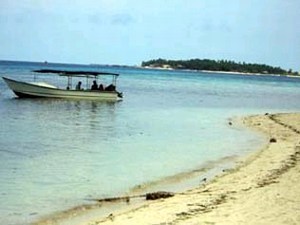Kapoposang National Marine Park: South Sulawesi
 Kapoposang National Marine Park may not be as well-known as other celebrated diving resorts, like Bunaken of North Sulawesi or Raja Ampat in Papua, but it is equally beautiful and offers an abundance of unexplored marine life. Located in the Makassar Strait some 20 nautical miles northwest of South Sulawesi‘s capital of Makassar, Kapoposang National Park is a coral conservation area in the central part of Indonesia. It takes around two hours to reach the area from Paotere Tallo port in Makassar, crossing the strait by speedboat. There is also the option of a three-and-a-half hour trip departing from Maccini Baji port in Pangkep regency. But no matter how long it takes to get there, and even though the afternoon brings stronger winds and higher waves, the trip is worthwhile.
Kapoposang National Marine Park may not be as well-known as other celebrated diving resorts, like Bunaken of North Sulawesi or Raja Ampat in Papua, but it is equally beautiful and offers an abundance of unexplored marine life. Located in the Makassar Strait some 20 nautical miles northwest of South Sulawesi‘s capital of Makassar, Kapoposang National Park is a coral conservation area in the central part of Indonesia. It takes around two hours to reach the area from Paotere Tallo port in Makassar, crossing the strait by speedboat. There is also the option of a three-and-a-half hour trip departing from Maccini Baji port in Pangkep regency. But no matter how long it takes to get there, and even though the afternoon brings stronger winds and higher waves, the trip is worthwhile.
Upon arriving ashore on Kapoposang island, a white sandy beach and crisp water reflecting the sunlight are a welcoming treat for the eyes according to Desy Nurhayati.
The clear water enables people to observe miscellaneous shore plants and fish from the boat.
According to 2007 data from the Indonesian Institute of Sciences (LIPI), there are 68 genera (groups of closely similar species) of reef that are home to more than 160 species of fish.
Yet, Kapoposang National Park is rarely visited by tourists.
Along the coastline, you will only meet local fishermen riding katamarang, their traditional boats.
Local community leader Haruna said the park was only visited every couple of months or so by people wishing to snorkel or dive.
“Most of them are from the Makassar Diving Club. There are also some domestic and foreign travelers,” Haruna said.
Not much has been done by the provincial administration to develop the park as a potential tourist attraction.
Only two bungalows have been built on the island and a rusty board reading “Taman Wisata Alam Kapoposang” is the only existing sign for the location.
The quiet island of Kapoposang is home to some 100 families that live in stilt houses. The residents usually go to Pangkep by speedboat once a month to buy supplies.
“We pay Rp 2,000 per day for electricity and it only comes on from 6 p.m. to 9 p.m.,” Haruna said.
Despite not being a popular destination for travelers, Kapoposang island, part of the Spermonde archipelago located between Sulawesi and Kalimantan, has been declared a coral conservation area with dominant coral specie Acropora sp., Pachyseris speciosa and Porites nigrescen.
Five nearby islands — Papandangan, Kondongbali, Suranti, Pamangangang and Tambakulu — are also preservation zones; the latter three unpopulated.
The conservation effort has been conducted under the Coral Reef Rehabilitation and Management Program (Coremap), which was initiated by the Ministry of Fisheries and Marine Affairs in 1998.
Coremap aims to establish the sustainable management of marine resources that have been degraded due to human and natural threats.
The Coremap scheme empowers local people to safeguard marine life against destructive fishing and overfishing.
Some protected zones have been set by the local people through the installment of marine buoys.
“The people here have started to take part in preserving this area. They remain alert for outsiders using explosives to catch fish or disturbing the protected zones,” Haruna said.
He said non-governmental organizations had also participated in conserving the area over the last few years.
Head of the coral research center at Hasanuddin University of South Sulawesi, Jamaluddin Jompa, said the amount of living coral at Kapoposang was currently around 80 percent.
“Even so, we have to remain alert since destructive fishing and overfishing have threatened the area,” he said.
Research has revealed most of the coral reefs across the country are being degraded.
The latest research conducted by LIPI, which encompassed 908 observation sites across the country, shows 32.05 percent of Indonesia’s coral reefs have been damaged.
“Destructive fishing by using bombs and cyanide, as well as the taking of living coral, fishermen anchoring at unsuitable sites and divers stepping on coral are also major threats,” Jamaluddin said.
In some areas of Spermonde archipelago, there is the common perception that marine life is anyone’s for the taking, with many people feeling free to exploit its abundant resources. Fishermen coming from other areas freely enter the zone without strict control or resistance from local fishermen.
Supervision efforts against environmental criminals are hampered due to a lack of facilities.
“It’s difficult to safeguard remote areas and observe the condition of coral reefs due to limited boats and telecommunication devices,” said Ikhsan Mahfud, Coremap’s senior extension and training officer in Kapoposang.
Through continuous advocacy efforts, it is hoped the Kapoposang National Park, one of the many superb snorkeling and diving spots in Indonesia, will develop into a more popular tourist destination.